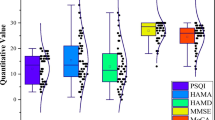Abstract
Objective
In restless legs syndrome (RLS), the prevalence of depressive symptoms and anxiety has been found to be increased. However, most studies did not consider specific personality characteristics of patients although they might have a crucial influence on the mental state of the patient. The aim of this study was to compare RLS patients with healthy controls in view of personality traits, depression, and anxiety.
Methods
In all, 30 consecutive patients with idiopathic RLS (de novo) were compared to 30 age- and sex-matched healthy controls. The severity of symptoms was assessed using the RLS severity scale. Sleep disorders, depression, and anxiety disorders were exclusion criteria for the control group. Participants were asked to fill in the NEO Five-Factor Inventory (NEO-FFI) to assess personality traits, as well as the Self-Rating Depression Scale (SDS) and the Self-Rating Anxiety Scale (SAS).
Results
RLS patients scored significantly higher on the SDS (39.0 ± 7.4 vs. 28.8 ± 5.7, p < 0.001) as well as the SAS (37.4 ± 4.9 vs. 26.0 ± 4.3, p < 0.001) compared to the control group. In the NEO-FFI, patients exhibited significantly higher scores on the subscale “neuroticism” (52.3 ± 8.4 vs. 41.6 ± 9.0, p < 0.001). In addition, they scored significantly lower on the subscales “openness to experience” (45.3 ± 6.9 vs. 51.9 ± 10.5, p = 0.007) and showed a trend in “agreeableness” (48.6 ± 11.5 vs. 55.5 ± 9.6, p = 0.017; ns after Bonferroni correction) compared to healthy controls.
Discussion
RLS patients seem to be more worried, nervous, and discontent. They are more easily irritable and more vulnerable to stress. They also tend to withdraw from social contacts and rather occupy themselves with their symptoms.
Zusammenfassung
Ziel
Die Prävalenz von depressiven und Angstsymptomen ist beim Restless-Legs-Syndrom (RLS) erhöht. Die spezifische Persönlichkeit wurde jedoch in den meisten Studien nicht berücksichtigt, obwohl sie einen erheblichen Einfluss auf die psychische Verfassung haben kann. Ziel dieser Studie war es daher, Persönlichkeitsmerkmale, Depression und Angst von RLS-Patienten im Vergleich zu Gesunden zu untersuchen.
Patienten und Methoden
Dreißig konsekutive Patienten mit idiopathischem RLS (de novo) wurden mit 30 alters- und geschlechtsgleichen gesunden Kontrollen verglichen. Der Schweregrad des RLS wurde mit der RLS-Schweregradskala gemessen. Schlafstörungen, Depression und Angststörungen waren Ausschlussmerkmale bei den Kontrollen. Alle Teilnehmer füllten das NEO-5-Faktoren-Inventar (NEO-FFI) aus, um die Persönlichkeitsmerkmale darzustellen, außerdem die Self-Rating Depression Scale (SDS) und die Self-Rating Anxiety Scale (SAS).
Ergebnisse
RLS-Patienten hatten signifikant höhere Werte in der SDS (39,0 ± 7,4 vs. 28,8 ± 5,7; p < 0,001) und in der SAS (37,4 ± 4,9 vs. 26,0 ± 4,3; p < 0,001). Im NEO-FFI zeigten die Patienten signifikant höhere Werte in der Subskala „Neurotizismus“ (52,3 ± 8,4 vs. 41,6 ± 9,0; p < 0,001). Außerdem zeigten sie signifikant niedrigere Werte in den Subskalen „Offenheit für Erfahrung“ (45,3 ± 6,9 vs. 51,9 ± 10,5; p = 0,007) und zeigten einen Trend für „Verträglichkeit“ (48,6 ± 11,5 vs. 55,5 ± 9,6; p = 0,017; nichtsignifikant nach Bonferroni-Korrektur) im Vergleich zu den gesunden Kontrollen.
Diskussion
RLS-Patienten scheinen ängstlicher, nervöser und unzufriedener zu sein. Sie sind leichter irritierbar und anfälliger für Stress. Sie tendieren außerdem dazu, vor sozialen Kontakten zurückzuschrecken und beschäftigen sich vermehrt mit ihren Symptomen.
Similar content being viewed by others
References
Winkelmann J, Prager M, Lieb R et al (2005) “Anxietas tibiarum”. Depression and anxiety disorders in patients with restless legs syndrome. J Neurol 252:67–71
Kalaydjian A, Bienvenu OJ, Henning WA et al (2009) Restless legs syndrome and the five-factor model of personality: results from a community sample. Sleep Med 10:672–675
Walters AS (1995) Toward a better definition of the restless legs syndrome. The International Restless Legs Syndrome Study Group. Mov Disord 10:634–642
Allen RP, Picchietti D, Hening WA et al (2003) Restless legs syndrome: diagnostic criteria, special considerations and epidemiology. A report from the restless legs syndrome diagnosis and epidemiology workshop at the National Institutes of Health. Sleep Med 4:101–119
Becker PM, Ondo W, Sharon D (1998) Encouraging initial response of restless legs syndrome to pramipexole. Neurology 51:1221–1223
Borkenau P, Ostendorf F (1993) NEO-Fünf-Faktoren Inventar (NEO-FFI) nach Costa und Mc Crae. Handanweisung. Hogrefe, Göttingen
Zung WWK (1965) A self-rating depression scale. Arch Gen Psychol 12:63–70
Zung WWK (1971) A rating instrument for anxiety disorders. Psychosomatics 12:371–379
Buysse DJ, Reynolds CF 3rd, Monk TH et al (1989) The Pittsburgh sleep quality index: a new instrument for psychiatric practice and research. Psychiatry Res 28:193–213
Lehto K, Akkermann K, Parikh J et al (2013) Effect of COMT Val158Met polymorphism on personality traits and educational attainment in a longitudinal population representative study. Eur Psychiatry pii: S0924–9338(13)00082–5. doi:10.1016/j.eurpsy.2013.06.008. (Epub ahead of print)
Suridjan I, Boileau I, Bagby M et al (2012) Dopamine response to psychosocial stress in humans and its relationship to individual differences in personality traits. J Psychiatr Res 46:890–897
Lee IH, Cheng CC, Yang YK et al (2005) Correlation between striatal dopamine D2 receptor density and neuroticism in community volunteers. Psychiatry Res 138:259–264
Acknowledgment
The authors thank Karin Mayer for contacting patients and help in acquisition of data.
Compliance with ethical guidelines
Conflict of interest. J. Steinig, T. Reess, G. Klösch, C. Sauter, J. Zeitlhofer, and S. Happe state that there are no conflicts of interest.
All studies on humans described in the present manuscript were carried out with the approval of the responsible ethics committee and in accordance with national law and the Helsinki Declaration of 1975 (in its current, revised form). Informed consent was obtained from all patients included in studies.
Author information
Authors and Affiliations
Corresponding author
Rights and permissions
About this article
Cite this article
Steinig, J., Reess, T., Klösch, G. et al. Personality traits in patients with restless legs syndrome. Somnologie 17, 281–283 (2013). https://doi.org/10.1007/s11818-013-0623-z
Received:
Accepted:
Published:
Issue Date:
DOI: https://doi.org/10.1007/s11818-013-0623-z




